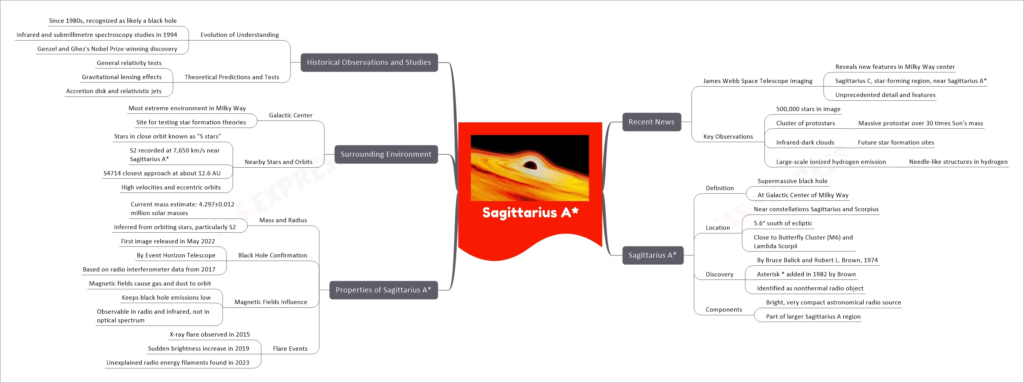Sagittarius A*
In a groundbreaking achievement, the James Webb Space Telescope has unveiled new features of the Milky Way’s center, providing unprecedented insight into the star-forming region Sagittarius C and its vicinity to Sagittarius A*, the galaxy’s central supermassive black hole.
Sagittarius A* Defined
Sagittarius A*, a supermassive black hole, resides at the heart of the Milky Way. Discovered in 1974 by Bruce Balick and Robert L. Brown, it was later named for its strong radio emissions. Located near the Sagittarius and Scorpius constellations, it’s a critical part of the larger Sagittarius A region.
Key Characteristics
- Mass and Radius: The mass of Sagittarius A* is estimated at approximately 4.297±0.012 million solar masses. This estimation is primarily based on the observations of nearby orbiting stars, notably star S2.
- Confirmation as a Black Hole: In May 2022, the Event Horizon Telescope released the first image of Sagittarius A*, confirming its black hole status.
- Magnetic Field Influence: Observations reveal that magnetic fields direct surrounding gas and dust into orbit around Sagittarius A*, maintaining low black hole emissions. These emissions are visible in radio and infrared wavelengths but not in the optical spectrum.
- Flare Events: Sagittarius A* has shown various flare events, including a significant X-ray flare in 2015 and a dramatic increase in brightness in 2019. Additionally, in 2023, unexplained filaments of radio energy were associated with it.
Surrounding Environment
The center of the Milky Way, where Sagittarius A* is located, offers the most extreme environmental conditions in our galaxy. It serves as a crucial site for testing star formation theories.
Orbiting Stars
- “S Stars”: A group of stars, known as “S stars,” orbit closely around Sagittarius A*. These stars, including S2 and S4714, are observed primarily in infrared wavelengths due to interstellar dust interference.
- Astrophysical Observations: The proximity, high velocities, and eccentric orbits of these stars provide valuable data for establishing the physical dimensions of Sagittarius A* and for observing effects associated with general relativity.
Historical Observations and Studies
Since the 1980s, the central component of Sagittarius A* has been considered a likely black hole. This hypothesis was supported by infrared and submillimetre spectroscopy studies in 1994.
Theoretical Predictions and Tests
- Testing General Relativity: Observations of Sagittarius A* have provided opportunities to test Einstein’s theory of general relativity.
- Gravitational Lensing: The phenomenon of gravitational lensing around Sagittarius A* offers insight into the theoretical predictions about black holes.
- Accretion Disk and Relativistic Jets: The presence of an accretion disk and potential relativistic jets near the event horizon of Sagittarius A* aligns with black hole theories.
Conclusion
The recent advancements in observing Sagittarius A*, including the detailed imagery from the James Webb Space Telescope, have significantly enhanced our understanding of the dynamic and complex environment at the center of our galaxy. These insights not only deepen our knowledge of Sagittarius A* but also contribute to the broader understanding of black holes and galactic dynamics.
If you like this post, please share your feedback in the comments section below so that we will upload more posts like this.


